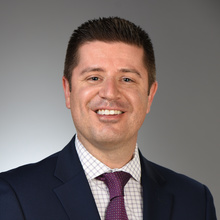
The present and future direction of health care is all about delivering unique and personalized health care. Being able to meet the exact needs of a patient, while considering their distinct attributes with a precise and measured treatment is revolutionizing the health care industry. Dentistry is no exception, and Dr. Christopher Barwacz’s research is focused on improving treatment outcomes for patients receiving oral implants so that a given dental implant and its prosthetic components are customized for a given patient, rather than trying to fit the patient to a formulaic therapeutic regimen.
Although the field of oral implantology started to take off in the mid-1980s, it wasn’t until this century that the field matured—as it moved beyond a focus of obtaining predictable and successful results pertaining to the bone growing around and supporting an implant to a focus on personalizing and optimizing implant therapy with the goal of expanding the pool of patients who could receive implant replacement therapy without affecting treatment outcomes. To achieve such ends, a focus of research efforts was needed to investigate factors in the transition zone between an implant body and its prosthetic crown that helped contribute to success.
Dr. Barwacz, associate professor in the Department of Family Dentistry, is a leader in personalizing and optimizing implantology, and his research has moved along three main directions to support these goals.
The first direction explores the outcomes of shorter implants (6 mm) versus a traditional implant (≥11 mm).
“Historically, some patients weren’t good candidates for implants without undergoing significant augmentation procedures because their anatomy made it difficult to place a traditional-length implant,” Barwacz explained. “But we found that shorter implants, when planned and restored properly, had a similar long-term success rate to traditional implants, which allows us to optimize the implant length to the anatomical needs of the patient, and treat them in a more minimally-invasive fashion, thereby allowing more patients to potentially receive care.”
In the second, Barwacz and his team investigated the biocompatibility and longer-term prosthetic outcomes of biomaterials used in the fabrication of patient-specific, digitally-designed and manufactured custom abutments, which anchor the prosthetic tooth of the implant to the underlying implant body. “Just because a prosthetic component is still ‘in function’ does not necessarily mean it is ‘successful’, when taking into account factors such as inflammation, discoloration, tissue support, and patient-reported outcomes,” Barwacz said. “The nature of how the prosthetic connection between an implant and its corresponding abutment is designed, as well as the morphology of the abutment as it emerges through the mucosa can potentially have a significant influence on biological stability of the peri-implant tissues, making this an exciting area of research.”
The third direction harnesses the power of digital dentistry to optimize implant therapy. With a digital rendering of the patient’s teeth, mucosa, and supporting bone, the clinician can not only plan the surgery virtually, but can also design and manufacture the custom patient-specific prosthetic components a priori before the actual surgery, resulting in the capability to either immediately restore the missing tooth, or to guide healing post-surgery in a customized fashion. This leads to less morbidity, a more predictable surgery, and the potential to expedite treatment that is patient-centered with a unique treatment solution.
In each of these projects, Barwacz’s approach is multidisciplinary and involves close collaboration with colleagues as well as industry partners.
“Oral implantology is deeply multidisciplinary—to optimize outcomes, you need to collaborate closely with quality-oriented specialists in many different areas to ensure that the final restorative outcome meets the needs of the patient optimally,” Barwacz said.
Through it all, Barwacz’s approach is to start with the end goal in mind and work backwards starting with the patient’s desired endpoint and the specifics of the implant site’s biology to customize care. Incorporating multicenter and multidisciplinary clinical research collaborations to help establish evidence-based protocols that expand and improve outcomes for patients in the future brings Dr. Barwacz the most professional satisfaction.